
The Farplane, the plane of afterlife in the Final Fantasy X series.
The afterlife refers to the concept of continued existence after the death of one's body. Various concepts of afterlife as well as literal realms of afterlife appear in the Final Fantasy series. One's existence in an afterlife in the series can be physical or transcendental, and many concepts seen as nebulous in the real world gain a corporeal existence in Final Fantasy, such as life essence or souls appearing as physical matter that mortals can apprehend and interact with. The worlds' life energy is often represented by crystals.
Afterlife is in contrast to oblivion after death. Barring one's entrance to the afterlife is a recurring story element in the series, sometimes as a result of the souls being a form of corporeal matter in the world, and people either knowingly or unwittingly using said matter for purposes unintended by nature. One's continued existence often takes place in a spiritual realm that may or may not have geographical continuity with the mortal world. Other worlds have a cycle of reincarnation, most notably the Fabula Nova Crystallis: Final Fantasy games. Still others combine both concepts, with Final Fantasy XIV presenting the aetherial sea as the source of all souls to which they temporarily return after death. The planes of afterlife can be part of the natural order of things, or be determined by deities.
Appearances[]
Final Fantasy II[]
The bonus quest Soul of Rebirth appears to take place in a type of afterlife or a realm between life and death.
Minwu awakens following his sacrifice, and exploring the area meets up with Scott, Josef and Ricard. They at first surmise they are in the Jade Passage, the pathway to Hell, since they are dead. The four find Machanon, a village whose citizens are dead victims of the Emperor's conquest, including Cid and Tobul. The people appeared in this mysterious monster-infested realm and have lost many. Cid believes that though the region is full of deadly monsters, it is not Hell, as if it was, it is unlikely innocent children would have appeared here.

The party meets the Emperor in Heaven.
The four enter the teleporter at the north edge of town and enter what Minwu says is Pandaemonium, palace of Hell. They climb to the highest floor where they find the Emperor. When Firion and his allies killed him, the Emperor's soul was split; his "dark half" fell to Hell and acquired more power, while his light half—the Emperor Minwu and the others now see—ascended to Heaven. The Emperor explains that they stand in Arubboth, palace of Heaven, and the cave they traveled through was Raqia, the place where fallen angels are cast down to become demons. The Emperor called them here to ask for forgiveness on the behalf of his dark half, and offers them eternal life with him in Arubboth if they forgive his sins.
Though the four are tempted, apparitions of their loved ones show them a vision of Firion and his allies battling the Dark Emperor in Pandaemonium. Realizing the Light Emperor is just as evil as the original, the four reject his offer, and engage him. Defeated, the Light Emperor declares their history of war and violence will continue, and dies just as Firion and his allies vanquish the Dark Emperor. As the rebels in the world of the living celebrate their victory, the specters of Minwu, Scott, Josef and Ricard watch them and wish them well. When their former allies leave, the four agree that their time is up, and they fade away into peaceful rest.
Final Fantasy IV[]
The dead can appear to mortals as ethereal beings.
Kluya is a Lunarian from the Red Moon who became interested in the Earth, and settled there. He fell in love with a human named Cecilia and fathered two children, brought with him the Lunar Whale space ship, and taught mankind technology and magic. Kluya was killed by a rival faction of villagers who disagreed with his teachings, but his spirit continues to have an effect on the mortal realm. A mysterious light appears when Kluya's son, Cecil Harvey, undergoes the trials of Mount Ordeals to become a Paladin, calling him "my son".

Cecil speaking with his father's spirit.
Some time after Cecil and his friends save the world, Kain Highwind trains on Mt. Ordeals and hears Kluya's voice calling to him. Kain battles and loses to his mirror self, and the mirrored chamber is shattered as Dark Kain escapes to the outside world.
Kluya's ultimate fate is unknown—when Porom enters the mirrored chamber at Mount Ordeals, Kluya paradoxically tells her "I... am about to fade... But my spirit...will never be extinguished".

Anna's spirit.
Another example of the dead apprehending the living is when Anna's spirit appears to Edward. She was his lover who had taken the arrows meant for him. After Rosa recovers from Desert Fever, Edward goes to play his harp near the oasis in Kaipo, but ends up fighting a sahagin. Anna's ghost appears and tells Edward to believe in himself and be strong. She disappears after Edward defeats the sahagin, telling him to give his love for her to the world.
In the Lunar Ruins in Final Fantasy IV Advance and Final Fantasy IV: The Complete Collection, Edward's Trial revolves around giving the tortured soul eternal rest in Damcyan Castle's ruins. Edward must use the Requiem Harp to sing a requiem, thus allowing the soul peace.
Final Fantasy IV: The After Years[]
Anna's spirit appears with her father Tellah's in Kaipo. Tellah tells Edward that Anna wants him to find happiness. After the heroes again save the world, Anna and Tellah's spirits are seen by Edward, who thanks them.
When Golbez and Fusoya pray for the Lunar Whale to come to the Red Moon, Kluya prays with them. Later, Kain again confronts his dark side and this time defeats him. Kluya transforms Kain into a Holy Dragoon in recognition of his trials.
Final Fantasy V[]
Similarly to Final Fantasy IV, the dead can appear as "ghosts" to the living.
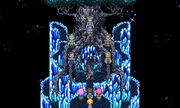
Galuf, the Warriors of Dawn, and King Tycoon's spirits appear before the final battle.
After Galuf passes away his spirit uses the power of the Guardian Tree to speak to his granddaughter Krile, telling her to fight in his stead. He assures her that he will always be in her heart and grants her his strength and abilities, and Krile succeeds Galuf as a Warrior of Light.
Galuf's spirit keeps assisting the party by contacting Krile. When the party faces Neo Exdeath Galuf and the other Warriors of Dawn, along with King Tycoon, aid the Light Warriors escape the Interdimensional Rift. If anybody falls in the final battle, Galuf restores them to the world of the living when the Light Warriors later visit the Guardian Tree.
Exdeath's existence is that of a collection of evil spirits that have become sentient and gained a corporeal body. After the malicious warlock-king Enuo was defeated and the Void was sealed away, humans turned to an alternative solution to purge their land of corruption and terror. The Great Forest of Moore provided a solitary prison for these malevolent souls, and they were sealed within a tree. The various souls made the tree self-aware, and it assumed a humanoid form, a being as evil as the many souls that had spawned him. The exact nature of these spirits is unknown, however.
Final Fantasy VI[]
Phantom Train is the carrier of souls to the afterlife. It is a sentient being that can talk. One of the stops from where it takes off from is the Phantom Forest.
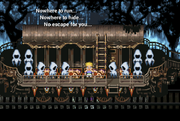
Ghosts on the Phantom Train.
Sabin, Cyan and Shadow accidentally board the Phantom Train and work their way to the front to stop it so they can disembark. They find the train inhabited by ghosts. When they attempt to stop the engine, they discover it is sentient. The engine attacks them, but is defeated, and so allows them to get off at the next stop. When they disembark, Cyan is anguished as he witnesses his deceased wife and son board the train along with the other victims of the destruction of Doma Castle.
When espers die they transform into magicite, crystals that host the esper's magic. Terra converses with the magicite of Maduin, implying that the magicite retain the sentience of the espers they once were. The magicite shatter once magic disappears from the world.
Humorously, the player can recruit a Ghost to their party while on-board the Phantom Train. The Final Fantasy Ultimania Archive lists its "likes and dislikes" as Hell and Heaven, respectively.[1]
Final Fantasy VII[]

Lifestream as shown in Final Fantasy VII: Advent Children.
The lifestream is an ethereal substance that streams beneath the surface of the planet of Gaia. It contains Gaia's essence and the memories, emotions, and knowledge of all who have lived on it. Portions of the lifestream are believed to be used to create new life on the planet, and the energy of a person returns to the planet when they die. Lifestream acts as an afterlife for the conscious spirits of the planet's inhabitants. Certain souls remain sentient after having returned to the planet, and gain control of the lifestream, becoming able to affect the physical plane from within it, and even able to communicate with those still living. Those who die and hold a resilient will and attachment to the living world in a place of negative disposition can return as ghosts and evil spirits.
The Shinra Electric Power Company devised a way to refine the lifestream into an electricity supplier, erecting mako reactors around the world to extract the energy from under the planet's crust. Shinra calls this energy source "mako". Refining lifestream into energy destroys the very life essence of the world, which is facing an ecological disaster.
The promised land is a quasi-mythical location believed to hold infinite amounts of mako deposits and is part of the Cetra legend. The Cetra were a race who traveled the planet, healing and cultivating it, and at the end of their journey would find the promised land, a land of supreme happiness. It appears the Cetra's promised land is not a physical location, but what the Cetra called the act of returning to the planet at life's end: joining the lifestream and becoming one with the planet.
In a scene both humorous and macabre, in Final Fantasy VII the player can find ghosts of the patrons of the Sector 7 Slums' Beginner's Hall at the Beginner's Hall in Upper Junon. They say they could not return to the planet before fully understanding Cloud's teachings. Another ghostly encounter is witnessed at the Sector 5 slums church. In Final Fantasy VII Remake, ghosts of children are found at the train graveyard, having been abducted by the demon Eligor. Defeating the demon releases the kids' spirits, allowing them to return to the planet. More evil spirits try to abduct children at the Sector 5 slums' graveyard, but Cloud and friends save them by defeating the spirits. In Final Fantasy VII Rebirth the Gi tribe were unable to enter the Lifestream when they died because they did not originate from Gaia.
Final Fantasy VIII[]
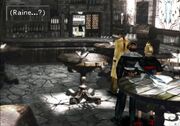
Squall hallucinates something that could be a ghost in Final Fantasy VIII.
The party can feel the presence of a ghost in the Winhill pub, and the woman who lives there claims that "spirits lurk within its walls." In Tomb of the Unknown King, the party will meet the king's ghost who talks about journeying to the "next world".
Sorceress power transcends death, as when a sorceress dies, it will pass unto another person.
Final Fantasy IX[]
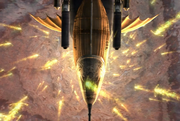
Golden lights at the Shimmering Island that may represent traveling souls.
Crystals reside at the centers of planets and are the source of all life; life is born from them, and souls return to them upon death. As the memories of living beings accumulate inside the crystals, the planets grow; thus the living beings on a planet could be seen as a collective soul for the planet itself. The crystal gives birth to new life on the planet, thus establishing a cycle of reincarnation. There is no specific plane of afterlife, but one's memories persist after their physical body dies. A soul is what gives the power of Trance to a person. During Final Fantasy IX, Garland from the dead planet of Terra tries to tamper with Gaia's soul cycle to revive his people.
Final Fantasy X[]
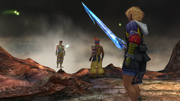
Wakka calls upon his late brother's image while visiting the Farplane.
The Farplane is an underworld in the inside of Spira. The Farplane is a gathering place for the dead who enter either by being sent by one like a summoner or a sender, or by accepting their death. Those who will not accept their death and are not sent to the Farplane remain as the unsent or fiends, both types able to send themselves by fulfilling a purpose they have failed to do in life.
The Farplane has geographical continuity with the rest of Spira, and can be visited by the living through an entrance at Guadosalam. Farplane is abundant in pyreflies that react to the visitors' memories to conjure an image of a dead person. The exact nature of the Farplane is not completely understood by the inhabitants of Spira.
Final Fantasy XII[]
It is implied that those of the Kiltia faith believe in an afterlife, as in Prince Rasler's funeral the priest who reads the rites asks for the Great Father to guide Rasler's body's return to the earth, and to guide his spirit's return to "the Mother of All" where he shall find peace. Ultima's clan primer meanwhile describes her as having been tasked with guiding souls to heaven and aiding in their reincarnation before her betrayal.

Ashe sees Rasler's ghost.
Prince Rasler's widow, Princess Ashe, begins to see visions of his ghost during her quest to reclaim her kingdom. She believes he is guiding her from beyond the grave. At the top of the Pharos however, she realizes the apparition is but a fake created by the Occuria to manipulate her, and accepts that Rasler is gone forever.
The Occuria consider themselves the gods of Ivalice, although it is implied they originate from Ivalice themselves. The Occuria have transcended to live in an otherworldly dimension that appears as a celestial plane when Ashe visits them. The Occuria cannot die, but appear to have a diminished ability to directly interact with the mortal plane, as even Venat, who has descended to Ivalice, possesses others to achieve its goals. The Occuria call themselves The Undying.
Beings continuing a shadowy existence after death is shown in couple instances. Most enemies simply collapse when killed, but the special Mandragora hunt monsters in Sochen Cave Palace turn into ghosts ![]() and float into the sky. A ghost of a man is found in the rainy Giza Plains who wants a ring returned to Elder Brunoa of the nomad village. If the player does so and returns to tell him, he fades away. Ghosts of children killed by Diabolos hire Vaan to hunt the mark and fade away after he returns, victorious. The nu mou at Nabreus Deadlands task Vaan with slaying Chaos in the three medallions sidequest, and likewise disappear after giving him the keys to unlock Chaos's lair.
and float into the sky. A ghost of a man is found in the rainy Giza Plains who wants a ring returned to Elder Brunoa of the nomad village. If the player does so and returns to tell him, he fades away. Ghosts of children killed by Diabolos hire Vaan to hunt the mark and fade away after he returns, victorious. The nu mou at Nabreus Deadlands task Vaan with slaying Chaos in the three medallions sidequest, and likewise disappear after giving him the keys to unlock Chaos's lair.
Final Fantasy XII: Revenant Wings[]
Anima is the part of a person's soul that allows them to feel emotion. It could be seen as the essence of a person, as if one's anima is stolen they become but a husk of their former self. The aegyls' stolen anima gives birth to Yarhi in the floating continent of Lemures, who live in an illusory world. This shadowy existence is not a true afterlife, however, but more like a prison.
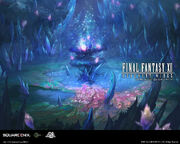
The world of illusion.
The aegyl god that wants to destroy Ivalice, Feolthanos, tricked Mydia by promising to resurrect her dead love, Velis. In reality he used her anima to create an illusion with Velis's form, and Mydia was possessed by Feolthanos's will and became the Judge of Wings. The party meets this Velis in the World of Illusion, the realm of the Yarhi. Before he transforms into the Yarhi Odin, Velis explains the relationship between anima and Yarhi: summoning Yarhi requires the summoner to surrender a piece of their anima, and surrendered anima that is tainted with evil becomes a beast. The illusion of Velis wants the party to destroy him so that Mydia can regain some of her stolen anima.
Final Fantasy XIII series[]
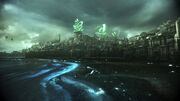
Valhalla, the middle realm between life and death.
The unseen realm is the realm of afterlife in Fabula Nova Crystallis: Final Fantasy series. It forms one half of the universe, where nothing has form, and is the natural location and source of chaos. Valhalla acts as a stepping stone between the unseen realm and the visible realm, the land of the living where humans and the fal'Cie exist. The unseen realm is the place where the souls of the dead, both humans' and deities', reside. The exact nature and appearance of the unseen realm is not defined as nothing has physical form there. In Valhalla, time does not flow properly, and it has no past, nor any future. The entire span of time can be seen from Valhalla, letting its few residents gain insight to every era and every different timeline. It is said that when the seeress of the Farseers gazes into the future, Valhalla is at the heart of the vision.
The souls exist in a cycle of reincarnation, and do not simply stay in the unseen realm indefinitely. When a human dies, their soul passes through the gate to the afterlife said to be operated by the goddess Etro, into the chaos of the unseen realm where it awaits its turn in the reincarnation process. When a human is alive, the soul is "stored" within their heart. Souls that fail to "make it" to the other side get trapped in the chaos. In Lightning Returns: Final Fantasy XIII, they can emerge from Chaos infusions as soul seeds. Some have tried to tamper with the seeds, but the results have been disastrous. The souls trapped in the chaos still retain their individuality as long as the living remember them. This works both ways; were the souls in the chaos destroyed, the living would forget the dead ever existed. Existence in the chaos is said to be perpetual anguish.
During the events of Final Fantasy XIII-2 and Lightning Returns: Final Fantasy XIII, the chaos of the unseen realm breaks into the visible realm, destroying the border between the two. The cycle of reincarnation is broken, and the dead stay trapped within the Chaos[2], yet still hold onto the hope of one day being reborn when the cycle of reincarnation would be reinstated. The god Bhunivelze wants to destroy these dead souls in the Chaos with the Soulsong. Lumina calls the souls of the departed the "winds of Chaos". This mixed realm is eventually destroyed as well, with its remains sucked into a newly created unseen realm with the reincarnation process renewing.
In Final Fantasy XIII: Reminiscence -tracer of memories-, Aoede glimpses the new unseen realm during her near-death experience, mentioning a sea of dark water where the souls fade. Caius Ballad and the various incarnations of seeress Paddra Nsu-Yeul now reside in the unseen realm to oversee world balance, and shepherd the souls to be either reincarnated, or lie at rest if the soul wishes not to be reborn.
Final Fantasy XIV[]
The religion of the Twelve in Eorzea believes that there are seven hells and seven heavens, with the god Nald'thal overseeing the afterlife. The religion of the Far East believes that the kami Izanami ushers the souls of the departed into the underworld and watches over them.
In truth, an individual's aether returns to the aetherial sea upon death. Many aware of this debate if a soul reincarnates or breaks down to be formed into new souls, with at least the first hypothesis being a reality of the world, with a mixture of both in some exceptions, although the vast majority of souls are shown to undergo reincarnation unbroken instead.
The aetherial sea, also known as the Lifestream, exists alongside the physical world but is normally invisible to the naked eye. It becomes visible the deeper one ventures into the planet's core where the physical and metaphysical spaces intersect. Hydaelyn made her home in the core of the aetherial sea where the Mothercrystal is located, able to temporarily summon a living person's consciousness into the aetherial sea to speak with, often using this with the Warrior of Light.
Teleportation magicks temporarily send a living person through the aetherial sea. If the destination aetheryte is destroyed, or the person in question uses the forbidden ancient teleport spell Flow, it is possible for someone to be lost in the aether.
Before the reality was fragmented and there was only a single world, the ancients Emet-Selch and Hythlodaeus were among a gifted few who had the ability to perceive the aetherial sea, which the ancients referred to as the Underworld.
The Sharlayans constructed two locations that descend far into the planet to observe and study the aetherial sea: The Antitower in the Dravanian Hinterlands, and later after abandoning that, The Aitiascope in Labyrinthos.
In Final Fantasy XIV: Heavensward, Y'shtola Rhul is lost in the aetherial sea after using Flow. She is saved by the Padjal of Gridania, who commune with the elementals of the land to bring her back to the physical world. Later, the Warrior of Light uses the Antitower to travel into the aetherial sea and speak with Minfilia Warde who has been taken by Hydaelyn. Later still, Urianger Augurelt concocts a plan to send the minds of the Scions of the Seventh Dawn and the Warriors of Darkness into the aetherial sea so they may speak with Minfilia and save Norvrandt.
In Final Fantasy XIV: Shadowbringers, Y'shtola is again caught in the aetherial sea after using Flow to survive a fall that would have killed her. Emet-Selch saves her, and has a much easier time than the Padjal did before owing to his mastery of aether.

In Final Fantasy XIV: Endwalker, the Scions of the Seventh Dawn use the Aitiascope to travel to the aetherial sea and encounter the remnants of both friends and foes alike from their journeys. Hydaelyn expends all her aether during her battle with the Scions, her burden to carry hope for the future passes to the Warrior of Light, and she fades into the aetherial sea to her long well-earned rest.
In the "Myths of the Realm" storyline, it is discovered that the seven heavens from Eorzean myth do exist, but they are not afterlives like Eorzeans believe, they are merely the domains of the Twelve.
Final Fantasy XV[]
Final Fantasy XV started development as Final Fantasy Versus XIII and part of the Fabula Nova Crystallis subseries. The kingdom of Lucis worshiped the Grim Reaper and the goddess of death, Etro. Those suffering a near-death experience were said to gain supernatural powers from the Kingdom of the Dead.
In the final game, the living monarch of Lucis gains power from the afterlife by wielding the combined powers of their ancestors with the Ring of the Lucii. The spirits of the dead pass to another realm, but the kings of Lucis stay linked to the mortal realm via the ring.
In ancient times, the civilization of Solheim associated life and death with the elements of fire and water; fire represented life and had multiple temples dedicated to it, while water represented the afterlife and large bodies of water were used in ceremonies to commemorate the dead.

Luna sinks into a blue abyss in Noctis's dream as she dies.
When Lunafreya Nox Fleuret dies, she speaks to Noctis Lucis Caelum in a dream world. The field of sylleblossoms the dream takes place in disintegrates and Lunafreya sinks into a blue abyss with black mist rising from the bottom. She promises to always look over Noctis. When on the train through imperial territory, Noctis hallucinates her presence that disappears when he reaches out to her, possibly indicating she is supporting him from the beyond. In the Windows and Royal Editions, Noctis meets Lunafreya's spirit in Insomnia as she summons the Astrals to dispel the Wall Ardyn Izunia had erected around the Citadel. When he touches her she disappears.
Bahamut has the power to either outright revive the dead, or prevent the dead from passing to the afterlife, allowing them a continued existence in the mortal realm. He has has done this with the Glaives in Final Fantasy XV: Comrades (including the player character) so they would serve his ends. The English localization all but omits this, however; there is only a loading screen saying the Glaives' lives are on loan from Bahamut, and Ardyn's line before their battle with Ifrit ("Try not to die this time"). In Final Fantasy XV -The Dawn of the Future-, Bahamut revives Lunafreya.
After Noctis dies, the Lucis Caelum dynasty ends and the Ring of the Lucii disintegrates, severing the kings' connection to the mortal realm and likely allowing the past rulers of yore to pass on to the afterlife. Lunafreya and Noctis appear on the throne of Lucis amid glimmering soul crystals and sylleblossom petals while being apprehended by King Regis's voice. While it could be taken to represent the afterlife, the Final Fantasy XV Ultimania posits it is deliberately ambiguous for players to make their own interpretation.[3]
amid glimmering soul crystals and sylleblossom petals while being apprehended by King Regis's voice. While it could be taken to represent the afterlife, the Final Fantasy XV Ultimania posits it is deliberately ambiguous for players to make their own interpretation.[3]

Noctis is supported by his friends and his father when he erases Ardyn.
Images of Noctis's friends and his father appear alongside him when he faces Ardyn in the void. Director Hajime Tabata later clarified Noctis's friends survive the ending,[4] and an image of the three in sunbathed Insomnia was added to the extra credits for the Royal Edition.
In past Final Fantasy games people's souls have returned to the planet's crystal, but the nature of the afterlife in Final Fantasy XV is ambiguous.
Final Fantasy XVI[]
Some beliefs to an afterlife are present, but beliefs appear to vary across Valisthea. The Ancestral Rite of Communion is a ceremony in Rosaria performed by the Dominant of Phoenix before setting out to battle, implying some belief in ancestors still being aware of mortal affairs and able to offer support from the beyond. Maeve in Tub & Crown in The Hideaway will talk about her beliefs on twilight after sunset blurring the "boundaries between this world and the next", which is why bad things tend to happen after sundown. After the Eikonic battle in Twinside, people float lanterns down the river to guide lost spirits to "their proper place".
Barnabas Tharmr, and thus presumably all believers of Circle of Malius, believe in the coming of a paradise that their god Ultima will create. In his last moments, Barnabas appears to believe he is about to enter the new world, and passes happily in religious fervor. However, Ultima was never going to let humanity into his new world: he was only using his followers to make the paradise for himself and his kin. In the end, Clive Rosfield defeats Ultima and absorbs his power, and Ultima never casts the spell that would have created this new world.
Final Fantasy Type-0[]

The spiral of souls.
As part of the Fabula Nova Crystallis series games, human souls entering the afterlife via a gate operated by Etro is part of the lore, although the normal cycle appears disrupted in Final Fantasy Type-0. The souls of Orience are stuck in an endless spiral until the deities that use them will find Agito. Orience is governed by four Crystals who erase the memories of the dead from the living, but where the souls end up in is unclear. Class Zero are able to harvest phantoma from the dead, which is said to be the life essence of living beings.
Crystals brand l'Cie to be their avatars in the world. When the l'Cie has fulfilled his or her purpose, they enter crystal stasis, which traps their soul to the mortal plane. Living can still remember sublimated l'Cie, suggesting that they are not dead, but merely in stasis, although mortals have various theories as to how the Crystals' memory erasure actually works. Arecia Al-Rashia, Class Zero's adoptive mother, can revive her cadets when they die.
The spiral is orchestrated by Arecia and Gala, divine servants to the gods Pulse and Lindzei. Arecia lives in the mortal plane as the archsorceress of the Dominion of Rubrum. She created Class Zero to use their powerful souls to force Etro's gate to open, as per the gods' plan to reach the unseen realm. This becomes known in the legends of Orience as Agito. Gala meanwhile sends his Rursan Reavers to slaughter everyone when Tempus Finis begins to release the souls of all Oriencians. After both fail to reveal the gate, Arecia resets the world and prepares for the next experiment. The two continue for 600,104,972 spirals until Arecia is convinced to end the experiment. Whether either Arecia's or Gala's method would actually work to reveal the gate is unknown, as the spiral revolves over 600 million times without result.
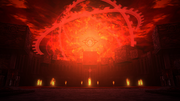
A depiction of Etro's gate above Pandæmonium.
Tempus Finis is the time when Orience faces destruction. Etro's gate is the barrier between the mortal world and the unseen realm, and is said to be found only by the deceased on their way to the other side. Pandæmonium is the land of judgment that appears during Tempus Finis where the Rursan Arbiter is to judge whether any of the souls sent to undertake his trials is the Agito. It is possible that those who die during Tempus Finis have their souls, or some essence of their souls, trapped in Pandæmonium forever, as Class Zero's voices can be heard in many of its hallways, confused, scared, and crying out for help. Though Class Zero has faced Tempus Finish many times before, they always failed to become Agito.
In the final spiral, the cadets again head for Pandæmonium as Cid Aulstyne becomes the Rursan Arbiter. The cadets fail Cid's final trial and are stricken down, but yet continue and pass through the fiery depiction of Etro's gate at the top of the sanctuary. They find Cid amid a pool of red liquid in a void-like dimension. This could allude to passing through the gate to the afterlife, but also could be allegorical rather than literal. The cadets engage Cid in his Rursan Arbiter form but are killed. Machina and Rem's crystal revives the cadets by transferring their power to the rest of Class Zero, and they kill Cid and thus stall Tempus Finis, but afterward perish themselves, mysteriously finding themselves back home for their final moments.
Arecia listens to the cadets' souls and learns they don't want to be revived. Although not directly stated, it is possible the cadets want to pass through Etro's gate and find their way to the afterlife as is the natural order of things. Arecia restores Machina and Rem to life from their crystal stasis and decides to allow the two and the rest of Orience to remember the dead. Arecia leaves Orience, and the spiral ends.

Ace is revived in an unknown realm.
In the Final Fantasy Type-0 HD remake extra ending, Ace, now wearing traditional samurai armor, has died in a snow-covered temple, and is revived by the power of the Phoenix.
Final Fantasy Legend II[]
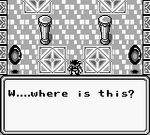
The party's first arrival.
Welcome to Valhalla Palace. People lost in wars come here.
Odin
Odin watches over fallen heroes in his palace, and has the power to revive. If the party dies at any point during their adventure, they will appear before Odin inside Valhalla Palace. He will greet the party, and revive them if they wish to continue. One of the leader's companions will point out that if they defeat Odin, he won't be able to revive the party anymore when they end up being defeated in battle. However, the party has no choice but to defeat him to move on to the next world.
Citations[]
- ↑ Final Fantasy Ultimania Archive Volume 1, p.309
- ↑ Lightning Returns: Final Fantasy XIII, Vanille: They've been drawn here, one after another. All the people who died after the Chaos poured through the gate. They've been swallowed by the Chaos, and now they're trapped inside.
- ↑ Final Fantasy XV Ultimania Scenario Side translations (Accessed: December 12, 2018) at The Lifestream
- ↑ Final Fantasy XV's Director Clears Up A Major Ending Plot Point (Accessed: June 02, 2018) at Kotaku
